Renderings of the proposed LRT alignment were presented at yesterday's Sub-Committee meeting.
By Ryan McGreal
Published May 03, 2016
Last Wednesday, the preliminary light rail transit alignment report was published on the City of Hamilton website. At yesterday's LRT Sub-Committee meeting, City LRT Director Paul Johnson delivered a presentation [PDF] with renderings of the LRT line at various points.
On the west end, the line will start at McMaster University at the corner of Main Street West and Cootes Drive:
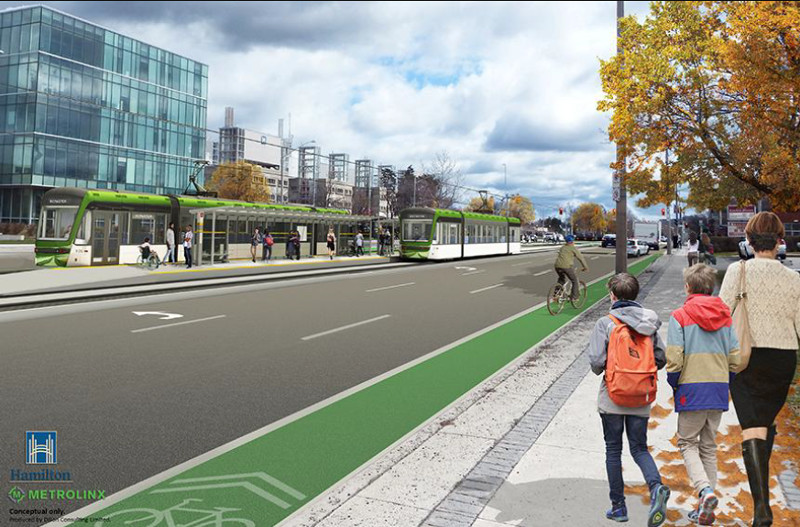
LRT alignment rendering at McMaster University
The line will proceed in both directions on dedicated lanes in the centre of Main Street West until just past Macklin Street South, where it will cross Highway 403 on a dedicated bridge that crosses diagonally and connects to King Street West at Cathedral Park.
From there, it will proceed in the centre lanes of King Street West, with one motor vehicle lane in each direction on the curb lanes. There will be two exceptions: between Queen and Hess, there will only be one lane westbound; and between John and Wellington, there will be only one lane eastbound.
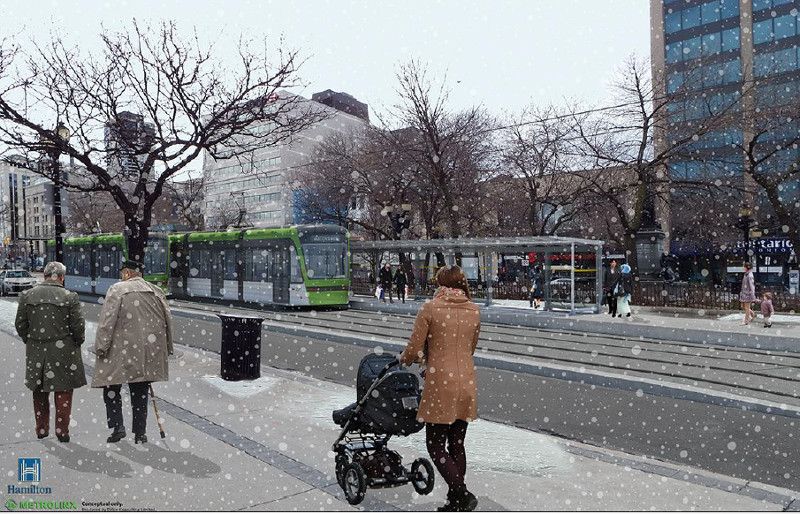
LRT alignment at Gore Park
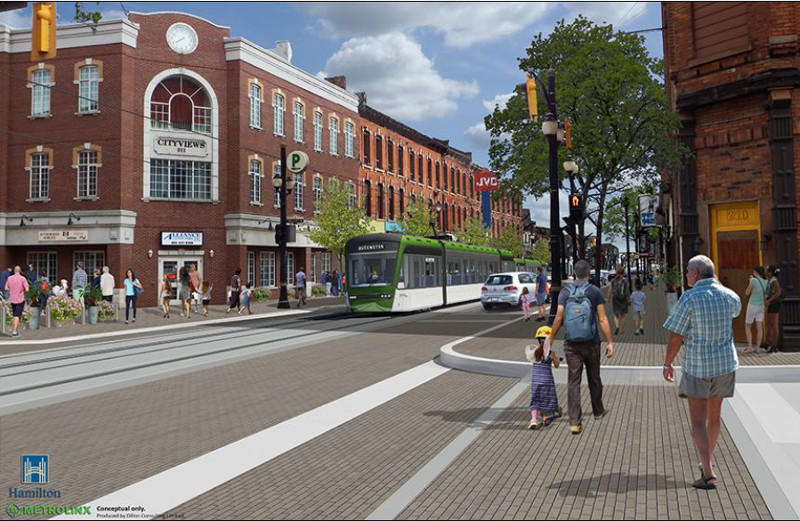
LRT alginment at King and Walnut
East of downtown, the line will run in the centre lanes out to the Delta, at which point it switches back to Main out to the Queenston Traffic Circle. There, a terminal will provide transfers to an express bus service out to Eastgate Square. (The LRT is proposed to be extended to Eastgate in a second phase of construction.)
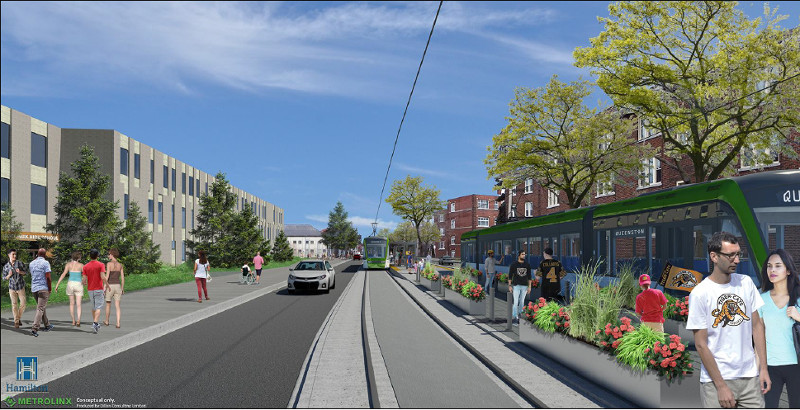
LRT alignment at Scott Park
In addition, a north-south spur line will run in both directions on James Street North from King Street to the West Harbour GO Station and, if funds allow, all the way to Guise Street and the Waterfront.
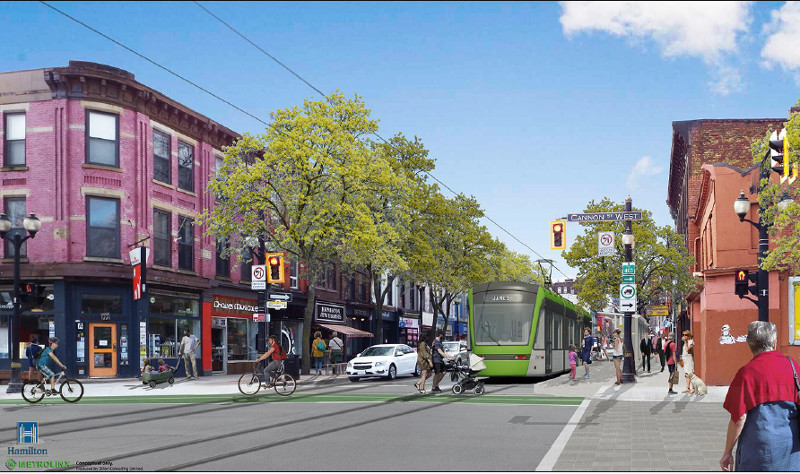
LRT alignment at James North and Cannon
Unlike the east-west line, the north-south line will run in mixed traffic.
The system is being designed in cooperation between the City and Metrolinx, with the Province responsible for produrement, funding, construction and operation of the line.
The City will be hiring 12 "LRT Community Connectors" to visit every property in the LRT corridor that will be affected by the project and meeting with the owners/occupants to make a personal connection, explain the LRT plan and direct any technical questions to the appropriate LRT Project employee.
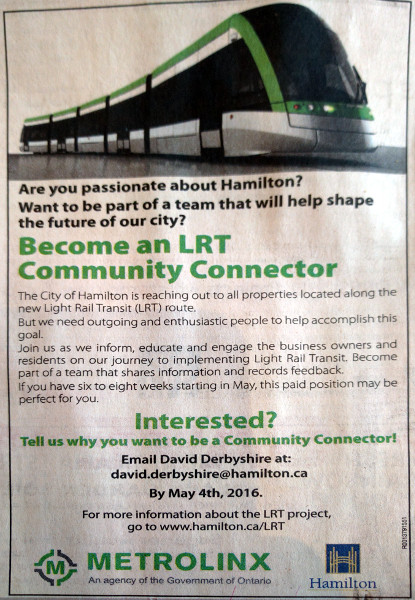
Print ad for the LRT Community Connector position
According to Kelly Anderson, LRT Communications and Engagement Manager for the City, they are looking for applicants who have excellent communications and service skills, the ability to manage conflict, and computer skills to input contact information into a city database. Ability to speak multiple languages is an asset.
There will be 12 positions available for around eight weeks, and the job pays $15 an hour. Interested applicants are advised to email David.Darbyshire@hamilton.ca by Wednesday, May 4. The timeline is short but the City hopes to begin outreach in late May or early June.
By Haveacow (registered) | Posted May 03, 2016 at 08:24:47
I know I am nit picking here but, couldn't they get the LRV's right! Are they actually going to be green and what's the deal with the 60's and 70's era European streetcar body design with a kind of 1990's LRV front and back end?
By Core-B (registered) | Posted May 03, 2016 at 12:57:26 in reply to Comment 118123
During the presentation, Paul Johnston made it perfectly clear that these are not what the LRV cars will look like. That decision hasn't yet been made.
By mdrejhon (registered) - website | Posted May 03, 2016 at 15:01:18 in reply to Comment 118158
Defacto, they are Bombardier Flexity Freedoms -- reversible double ended LRVs with doors on both sides.
I know Paul Johnson probably referred to the paint job, but the model is worth noting here. Given the Bombardier delays and the fact we're building a standardized 4'8½ gauge -- we do have the flexibility of choosing any common LRV, of similar length. This is flexibility that Hamilton has, that Toronto's TTC does not.
By Haveacow (registered) | Posted May 04, 2016 at 09:43:33 in reply to Comment 118161
Actually gauge is the easiest thing to change in modern LRV's especially if your non standard gauge is larger than standard or "Stevenson Gauge". All you have to do is insert a spacer that increases the distance between the flanges (wheels) and the body of the Truck or Bogie its really very easy. There are lots suppliers of Toronto, Pennsylvania (Philadelphia and Pittsburgh), and Boston Kits out there. All these transit operations have significant subway and or LRV operations with non standard gauge. In most cases there is no axel going all the way through the truck or bogie with modern low floor LRV's which allows significant storage space, in some cases like with the standard Russian Gauge of 1581 mm, it actually makes construction easier because there is a much more significant amount of space to add equipment.
In the case of all LRV's that been sold in North America until Toronto and Ottawa started their contracts, the design has been the standard 70% low floor LRV. The 70% low floor LRV has no low floor over the trucks but a raised platform, which normally has a interior ramp structure leading to it from the low floor sections of the vehicle. Toronto's Streetcars have had their production issues because the workers at both of Bombardier's North American LRV production sites, the Thunder Bay Assembly Plant and the Mexican Parts Fabrication Plant in Mexico have never built parts for or assembled a 100% Low Floor LRV before. The 100% Low Floor LRV is very common in Europe and Bombardier's European production facilities but not in North America. Unfortunately, it is the much more exacting design and production standards needed to build the 100% Low Floor LRV that is the problem. Our Bombardier workers have never done it before. Its like switching from building Business Jets and Commuter Aircraft to International medium-ranged Jet Airliners. They both fly but one is a lot more difficult, complicated and expensive to build as well as the reason so few companies around the world still make them. Bombardier even told both local and provincial politicians and managers at the TTC back in 2008 that, they would have preferred that Toronto's Streetcars be built in Europe to avoid this problem. Unfortunately, you can't tell people and politicians that, "sorry, your local workers just aren't good enough and need to be retrained before they build these types of LRV's in Ontario". No politician or TTC manager is going to admit to the press that we warned years ago that this would happen by Bombardier. The increased production that Bombardier is promising I bet, will be done via a European plant building key parts of the Toronto Streetcars and extra assembly work done in Ontario.
Toronto's Streetcars also have production complications because it is the only 30+ metre long, 100% low floor LRV in the world that is not limited to 25 metre radius turns at commercial speeds. Toronto Streetcars must negotiate 10.5-11 metre radius curves at or near commercial speeds. This has greatly complicated design factors. This particular design requirement was the reason Siemens Transportation North America, did not bid on the Toronto project, even when it was put up twice, for bidders. Most LRV companies do not want to go below the 25 metre turning radius requirement.
This by the way, was the real reason Siemens Transportation North America's CEO and CFO were fired, by the Siemens International Chairman back in 2008. They blew off the 204 LRV order for Toronto streetcars plus the options on possibly 300 more standard LRV's ordered for Ontario LRT lines, because they didn't want to alter existing production facilities to fit design changes needed so the Toronto Streetcars could make the tight turns at or near commercial speeds. Siemens had just completely finished a seriously needed corporate restructuring that saved the company from death. Many side businesses were sold off and other company product divisions simply disappeared. Also, the Transportation part of the company had lost a lot of LRV market share in Europe because of many design faults in the European standard Combino Class LRV. It was reported that the Chairman of Siemens International was so ticked off at his junior CEO and CFO in North America he responded that, for 204 LRV's and possibly hundreds more for other operations in Canada, all in the core territory of one of his biggest transportation competitors Bombardier, he would build them a whole F*ing factory.
Ottawa's LRV's also 100% Low Floor, had the floors and Trucks built in Europe at one of the Alstom LRV plants in France, then had exterior body and interior sections added at the their Platsburgh New York facility. Final vehicle assembly of the 48 metre long, 4 section Alstom Citadis Spirit LRV's are being done at Belfast Yards in Ottawa, right now as we speak!
By Boourns (anonymous) | Posted May 03, 2016 at 08:55:42
Since my question was ignored in the last LRT post, I'll ask again:
Won't B-Line Phase 2 construction along Queenston Rd hurt ridership since it will significantly slow that 'express' bus between QTC and Eastgate Square?
By Sure Failure (anonymous) | Posted May 03, 2016 at 15:33:52
Separate fares only ensures failure and no you dont love seniors if you deny them affordable transit
By Boourns (anonymous) | Posted May 03, 2016 at 18:32:18 in reply to Comment 118167
Separate fares would be devistating.
That on top of a five-to-ten minute wait to transfer at a cold outdoor QTC terminal.
Stoney Creek residents would be better off jumping on a GORER at Centennial to West Harbour -- one stop, no transfers.
By Suburbanite (anonymous) | Posted May 03, 2016 at 17:02:33 in reply to Comment 118167
Low income seniors is quite different than the huge discount we give for someone simply turning age 65. For example, aren't 4 of our elected officials over 65?
By Sure failure (anonymous) | Posted May 03, 2016 at 17:33:01 in reply to Comment 118169
If they are they have earned the discount
By mountain66 (registered) | Posted May 05, 2016 at 09:56:18
I know this has probably already been answered but why are they using King Street from the Delta to Macklin? The rest of the route is on Main so why didn't they just stay on Main through this section? It is much wider than King & would have avoided many of the problems going through downtown & the need for a new bridge. Also when I was living in Toronto the street cars had some problems in the winter on bends, staying on Main is straight but going to King will create bends at the Delta and on the west end getting back to Main. Also it would have been closer to the Hunter Street GO. It is also a one block walk to King so walking shouldn't have been a problem.
Comment edited by mountain66 on 2016-05-05 09:57:28
By kevlahan (registered) | Posted May 05, 2016 at 10:41:09 in reply to Comment 118291
You should ask the rapid transit team, but from the discussion back in 2009-2011 I believe the argument was that keeping LRT on King in that stretch would be better for traffic flow since Main has more lanes. Also, King is currently more pedestrian friendly with more shops etc. But the primary reason was motor vehicle traffic flow.
You must be logged in to comment.
There are no upcoming events right now.
Why not post one?